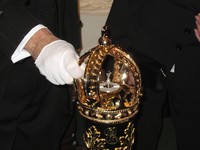 It was history in the making as the ceremonial mace was presented to the Sergeant-at-Arms by DeBeers Canada president Jim Gowan and Attawapiskat First Nation Chief Theresa Hall at Ontario’s Legislative Assembly in Toronto on March 24th.
It was history in the making as the ceremonial mace was presented to the Sergeant-at-Arms by DeBeers Canada president Jim Gowan and Attawapiskat First Nation Chief Theresa Hall at Ontario’s Legislative Assembly in Toronto on March 24th.
Proudly displayed within the head of the refurbished mace are two diamonds from the DeBeers’ Victor Mine, one cut and polished and the other in its original state.
"It was a really wonderful moment," said Tom Ormsby, manager of public and corporate affairs, DeBeers Canada Victor Mine. "We were trying to make sure people understood the partnerships we have with our local communities."
The rough stone represents the mine and a new industry in Ontario, while the cut and polished stone signifies the prosperity the industry can bring.
The diamonds
Ron Gashinski, chief gemmologist of the Ministry of Northern Development and Mines’ Diamond Sector Unit, picked out the stones from the mine’s first commercial run in March 2008.
"It was a privilege just picking out the stones," Gashinski said. "For me, that was the highlight. My job was done, but then to go forward and see it come to fruition was just another level of excitement and privilege."
Gashinski chose a 4.6-carat octahedron that yielded a two-carat gem easily visible within the mace. The second stone was an uncut, or rough, 2.16-carat octahedron.
"It was so sharp, it was like somebody cut it with a laser," he said. "It was a perfect crystal."
Gashinski also picked out a third stone described as a macle, which will be on display in its original state at Queen’s Park later in the year.
"Macles are difficult to cut," he said. "They are like two octahedrons that have been twisted with a herringbone going all the way around the stone. It was such a strong, clear-looking stone!"
He chose this triangular-shaped stone, keeping in mind the three representative sectors that worked together to bring the mine to fruition: First Nations, DeBeers with all its private sector partners, and the government.
Victor Mine project
Since the discovery of the diamond-bearing kimberlite located on First Nation traditional lands approximately 90 kilometres west of Attawapiskat, DeBeers has worked with local communities in the James Bay Lowlands to construct and bring Ontario’s first diamond mine into production.
The company struck various agreements with First Nations that included education and training programs, as well as employment at the mine. Now, with a workforce of between 375 and 400, approximately 42 per cent are Aboriginal.
"The people of Attawapiskat First Nation have played a significant role in the development and operation of the De Beers Canada Victor Mine," said Chief Hall in a March 24 company press release. "We will continue to work together in partnership with De Beers to further develop employment, training and business opportunities that result from the mine."
Also participating in the presentation at Queen’s Park was Nicole Edwards, a DeBeers’ employee who graduated from one of the process plant training programs. Her presence signified the opportunity and prosperity that the mine can bring to local communities, much like the cut and polished diamond set into the mace.
"Our goal is always to maximize benefits for the communities," said Ormsby.
Boasting an average annual production estimated at 600,000 carats, the DeBeers Victor Mine is known for producing consistently high-quality diamonds.
"About 85 per cent of their diamonds are gemstone quality," Gashinski said, which makes the Victor diamonds stand out from other diamond mines in the world.
The mace
The mace, a medieval weapon and once the symbol of the supremacy of the Crown, was first used for ceremonial purposes in 13th Century England and France. Now, it is a symbol of the Speaker’s authority, signifying the independence of Parliament.
The current mace was crafted in 1867 and is the third mace used in the province’s history. It bears the inscription of the Legislative Assembly’s motto "Audi alteram partem" – hear the other side.
The idea to set the two diamonds in the mace originated in April 2008 as an effort to recognize the three groups involved – First Nations, private sector and government. Award-winning designer Reena Ahluwalia designed the setting for the stones and Corona Jewellery Canada crafted the setting, and cleaned and replated the mace. Vale Inco supplied the platinum used in the setting, and Crossworks Manufacturing’s master diamond cutter, Jack Lu, spent more than 30 hours cutting and shaping the stone at the Legislature into a cut described as the "princess of hearts," a corner square modified brilliant cut.
The Honourable Steve Peters, the Speaker of the House, welcomed the eight representatives from those various parties including DeBeers, the provincial government and Minister of Northern Development and Mines Michael Gravelle, creating an historical event and proud memories for all those present.

